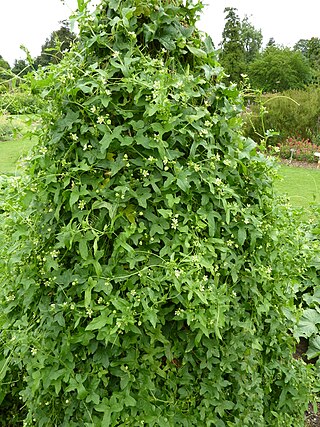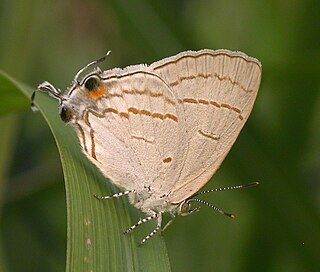
Firs are evergreen coniferous trees belonging to the genus Abies in the family Pinaceae. There are approximately 48–56 extant species, found on mountains throughout much of North and Central America, Europe, Asia, and North Africa. The genus is most closely related to Cedrus (cedar).

Teak is a tropical hardwood tree species in the family Lamiaceae. It is a large, deciduous tree that occurs in mixed hardwood forests. Tectona grandis has small, fragrant white flowers arranged in dense clusters (panicles) at the end of the branches. These flowers contain both types of reproductive organs. The large, papery leaves of teak trees are often hairy on the lower surface. Teak wood has a leather-like smell when it is freshly milled and is particularly valued for its durability and water resistance. The wood is used for boat building, exterior construction, veneer, furniture, carving, turnings, and various small projects.

Bryonia is a genus of flowering plants in the gourd family. Bryony is its best-known common name. They are native to western Eurasia and adjacent regions, such as North Africa, the Canary Islands and South Asia.

Coccinia grandis, the ivy gourd, also known as scarlet gourd, tindora and kowai fruit, is a tropical vine. It grows primarily in tropical climates and is commonly found in the Indian states, where it forms a part of the local cuisine. Coccinia grandis is cooked as a vegetable dish.

The scarlet gourds are a genus with 25 species. It is distributed in sub-Saharan Africa and with one species, C. grandis also in South and South-east Asia, and it is also introduced into the New World. Incidentally, C. grandis is also a cultivated crop and it is used for culinary and medical purposes.

Kaempferol (3,4′,5,7-tetrahydroxyflavone) is a natural flavonol, a type of flavonoid, found in a variety of plants and plant-derived foods including kale, beans, tea, spinach, and broccoli. Kaempferol is a yellow crystalline solid with a melting point of 276–278 °C (529–532 °F). It is slightly soluble in water and highly soluble in hot ethanol, ethers, and DMSO. Kaempferol is named for 17th-century German naturalist Engelbert Kaempfer.

The nightingale reed warbler, or Guam reed-warbler, is an extinct songbird that was endemic to Guam.
Bimba or BIMBA may refer to:

The large slit-faced bat is a species of slit-faced bat with a broad distribution in forest and savanna habitats in West, Central, and East Africa. N. marica, is the available name for the southern savanna species if it is recognized as distinct from this species.

Baridinae is a subfamily of true weevils (Curculionidae). It was established by Carl Johan Schönherr in 1836. Some 4,300 species in 550 genera are placed here, most of which occur in the New World. A few are economically significant pests, while others are in turn used for biocontrol of invasive plant pests. This subfamily also contains a few endangered species.
C. indica most often refers to:

Hypolycaena philippus, the purple-brown hairstreak or common hairstreak, is a butterfly of the family Lycaenidae. It is native to sub-Saharan Africa where it is commonly found in wooded locations.

Coccinia intermedia is a species of Coccinia which was first described in 2011 by Norbert Holstein.
Mattesia is a genus of parasitic alveolates of the phylum Apicomplexa. Species in this genus infect insects.

Coccinia grandiflora is an East African species of Coccinia which was first described in 1895 by Alfred Cogniaux.

Coccinia sessilifolia is a species of Coccinia from southern Africa.
Coccinia pwaniensis is an East African species of Coccinia that was first described in 2010.

Coccinia abyssinica is an Ethiopian species of Coccinia which was first described by Jean-Baptiste Lamarck. The tuber is under its Oromo name anchote a well-known local crop, but also the leaves are eaten.















